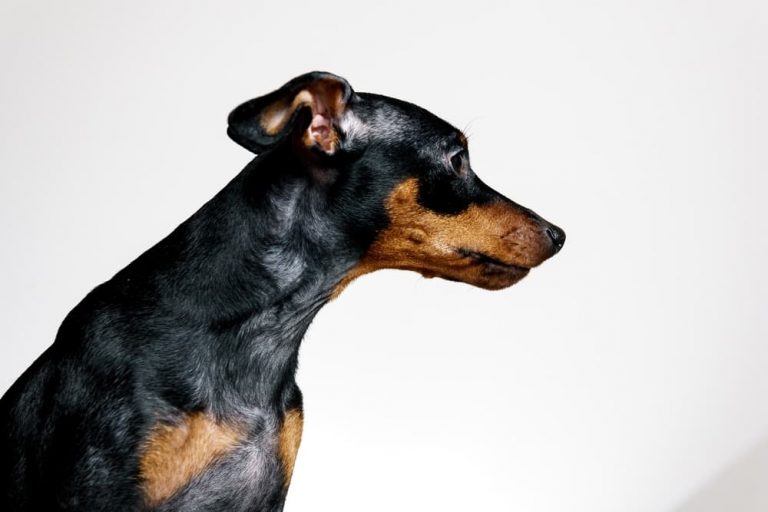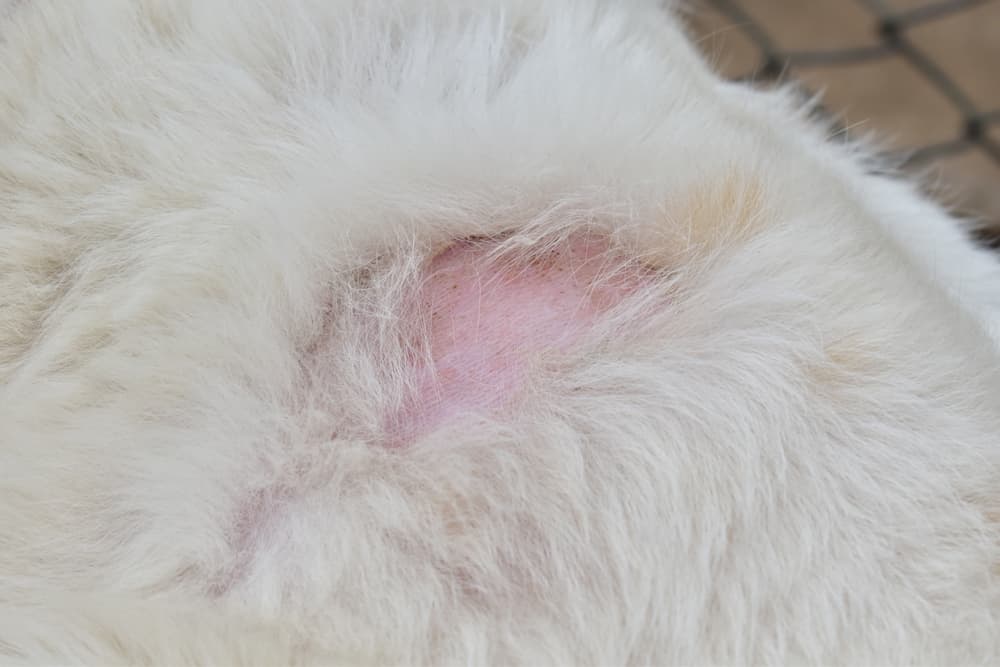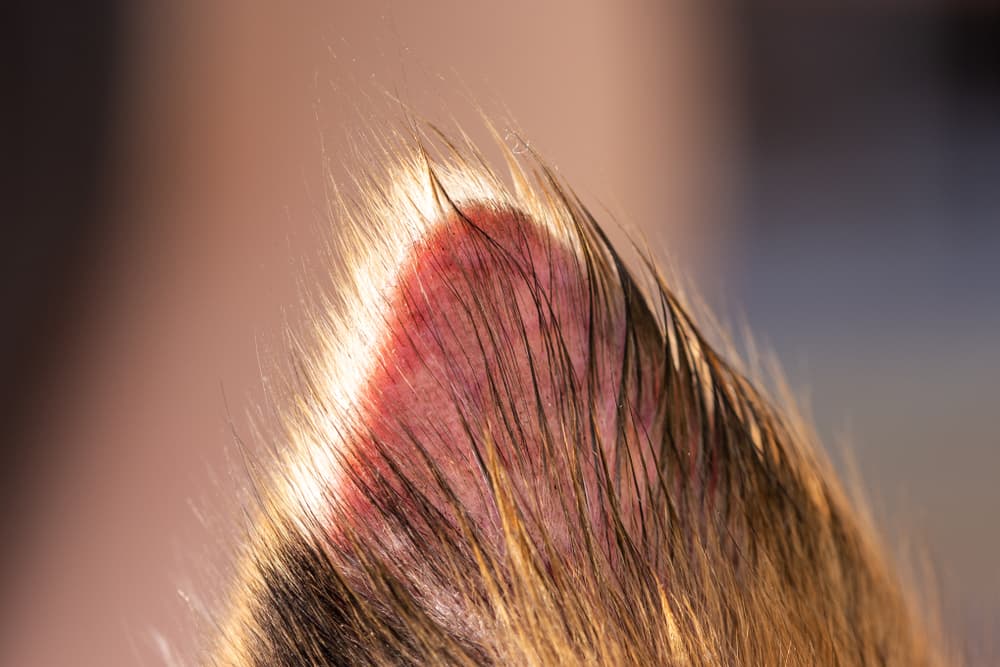Dog Losing Hair: 11 Causes and How to Help

Overview
Have you ever noticed your dog losing hair? And we’re not talking about typical shedding – we mean dog hair loss that results in patchy or bald areas of skin. It may be startling if it happens suddenly.
Alopecia in dogs is the medical term for hair loss. Alopecia is different from shedding because it results in baldness, whereas shedding does not. Shedding is often considered a normal process in dogs, and is caused by seasonal changes or stress.
A dog losing hair for reasons besides shedding is not normal. We’ll explore the different causes of alopecia in dogs and how you can help your dog if you notice hair loss.
What Is Alopecia in Dogs?
Alopecia in dogs is characterized by complete or partial loss of hair or fur in areas where hair is normally present.
It is usually caused by an underlying medical problem, either associated directly with the skin or indirectly through problems with metabolism, hormones, the immune system, or the blood and lymphatic system.
Alopecia is a very common disorder in dogs. Some breeds are predisposed to genetic causes of alopecia (which we’ll discuss in more detail below).
Types of Alopecia in Dogs
There are three main categories of alopecia in dogs that can help you determine why your dog is losing hair. These include:
Multifocal Alopecia. This is when dogs lose hair in multiple areas of their body.
Symmetrical Alopecia. This is when dogs lose hair on both sides of their body in a symmetrical pattern.
Patchy/Diffuse Alopecia. This is when dogs lose hair in patches or all over the body.
Symptoms of Alopecia in Dogs

The main symptom of alopecia in dogs is simply baldness where there was hair or fur before.
Beyond that, veterinarians use clues like what part of the body is affected, if the dog is itchy or the skin is inflamed, and the breed of the dog to determine the cause of hair loss.
Dogs that are losing hair due to medical issues with hormones or immune disorders may have additional symptoms, such as:
- Weight loss or weight gain
- Changes in appetite
- Increased thirst and urination
- Decreased energy
- Skin or urinary infections
- Crusty noses or eyelids
Why Is My Dog Losing Hair?

A veterinarian can help you determine why your dog is losing hair and the cause of your dog’s alopecia. Below are some common causes of hair loss in dogs:
Atopic Dermatitis
Atopic dermatitis is a chronic skin condition that affects roughly 10-15 percent of dogs [1]. It’s characterized by excessive itchiness, which often results in red, inflamed skin and hair loss. Atopic dermatitis is often linked to environmental allergens, such as pollen, dust mites, dander, and even food.
Demodex Skin Mites
Demodex mites can cause one small area of hair loss, multiple small patches of hair loss, or complete hair loss. Dogs infested with demodex mites may or may not be itchy, and their skin may be swollen, red and crusty or look completely normal.
Ringworm
Ringworm causes hair loss in one small area or multiple areas. It also causes scaly skin, redness, but it may not be circular.
Cushing’s Disease
Dogs with Cushing’s disease often show signs of symmetrical alopecia. This includes hair loss on the body, bacterial skin infections, and blackheads.
Bacterial Infections
Bacterial infections of the skin or hair follicles with Staphylococcus can cause circular hair loss with redness, pimples, crusting, and dark bumps.
Vaccines
Injections with vaccines or medication can cause localized inflammation and hair loss for 2-3 months after injection.
Inflamed Glands
Inflamed sebaceous glands in the skin of short-coated breeds can cause hair loss and crusty skin.
Hypothyroidism
When a dog’s thyroid is underactive, hair loss and balding can be a symptom of the disease.
Cancer
Dogs with lymphoma may display hair loss on the body with scaling and intense skin redness. These areas may later form plaques and nodules on the skin.
Keratinization Disorders
These disorders are associated with excessive dandruff and greasy skin, which may lead to hair loss in dogs.
Breed Predispositions for Hair Loss
Certain breeds may experience alopecia due to their genetics. The following are hair loss disorders and breeds who are predisposed to them:
- Breed-related alopecia. This is seen in hairless breeds, such as the Chinese Crested Terrier, Mexican Hairless, Inca Hairless, Peruvian Inca Orchid, and American Hairless Terrier.
- Hypotrichosis. This is a birth defect when hair does not grow normally. It is seen in Cocker Spaniels, Poodles, Whippets, Beagles, French Bulldogs, Yorkshire Terriers, Labrador Retrievers, Belgian Shepherds, Bichon Frise, Basset Hounds, and Lhasa Apsos.
- Color dilution alopecia. This is another genetic disorder seen in fawn or blue Doberman Pinschers, cream Chow Chows, blonde Irish Setters, blue Pit Bull Terriers, silver Labradors, and other breeds with dilute coat colors.
- Cyclical flank alopecia. This is seen in Boxers, English Bulldogs, and Airedale Terriers.
- Pinnal alopecia. This is alopecia on the tips of the ears. It is seen in Greyhounds, American Water Spaniels, Dachshunds, Boston Terriers, Portuguese Water Spaniels, Whippets, Italian Greyhounds, Chihuahuas, and Manchester Terriers.
- Alopecia X. This is also known as growth-hormone responsive alopecia. It is characterized by hyperpigmented skin on a dog’s neck and body. Alopecia X is most often seen in Pomeranians, Akitas, Chow Chows, Keeshonds, Siberian Huskies, Samoyeds, and Alaskan Malamutes.
Diagnosing the Cause of Dog Hair Loss

If your dog is losing hair, the best thing to do is go to a veterinarian for diagnosis and treatment.
A veterinarian will ask you questions about your dog and conduct a full physical examination. They can often get clues from the pattern of hair loss and whether the dog’s skin is itchy and inflamed.
Alopecia can be further diagnosed by the location on the body where hair is being lost. For instance, pinnal alopecia occurs on a dog’s ear tips; traction alopecia occurs on the top of the head due to a dog wearing rubber bands or barrettes that are too tight; and dermatomyositis is crusting and alopecia on the face, ear tips, tail, and feet.
However, if your veterinarian thinks there is an underlying medical cause like hormonal disorders or cancer that is causing your dog’s hair loss, they will likely want to run some additional laboratory tests.
Additional tests that may be ordered include:
- Blood and urine tests
- Skin scraping
- Fungal culture for ringworm
- Black light exam for ringworm
- Thyroid testing
- Testing for Cushing’s syndrome
- Other hormonal testing
- Skin biopsy
Cost of testing varies depending on what is the underlying cause: simple tests for ringworm cost less than $100. Hormonal testing or skin biopsies can run several hundred dollars.
How to Treat Alopecia in Dogs
Treatment for a dog losing hair depends on what is causing the alopecia.
If your veterinarian determines that your dog’s hair loss is linked to atopic dermatitis, they may recommend a fast-acting medication like Zenrelia (ilunocitinib tablets) to control the allergic itch. Zenrelia is an oral medication for dogs at least 12 months of age. You give your dog once a day, and it gets to work fast, easing itch and inflammation within 24 hours.

Read the entire package insert before using Zenrelia, including the Boxed Warning.
If alopecia is due to mites, the first step in treatment is eradicating the mites. If your dog’s hair loss is due to ringworm, then antifungals are required. If the cause is inflamed hair follicles and auto-immune skin disorders, anti-inflammatories, vitamins, and/or special shampoos may be prescribed.
Other treatments may include hormones, spay/neuter surgeries, retinoids, or melatonin. It all depends on what is causing the hair loss.
How to Prevent Hair Loss in Dogs

While not all causes of alopecia in dogs can be prevented, there are several measures you can take to ensure your dog doesn’t lose their hair:
Purchase puppies from reputable breeders. These breeders should guarantee their breeding stock to be free of genetic disorders that cause alopecia by showing you test results and offering a health guarantee.
Use flea and tick prevention. Use appropriate flea and tick control that also protects dogs against mites (ask your veterinarian).
Feed the right food. Feed your dog a complete and balanced diet. Proper nutrition supports overall skin and coat health, which can decrease excess oil production and reduce chances of bacterial infections.
Avoid hair accessories. Do not use tight rubber bands or barrettes in your dog’s hair.
Treat hormonal disorders. If your dog is diagnosed with a hormonal disorder like hypothyroidism or Cushing’s, have them treated appropriately to avoid losing hair.
References
- Hillier A, Griffin CE. The ACVD task force on canine atopic dermatitis (I): incidence and prevalence. Vet Immunol Immunopathol. 2001;81(3–4):147–51. doi: 10.1016/s0165-2427(01)00296-3









